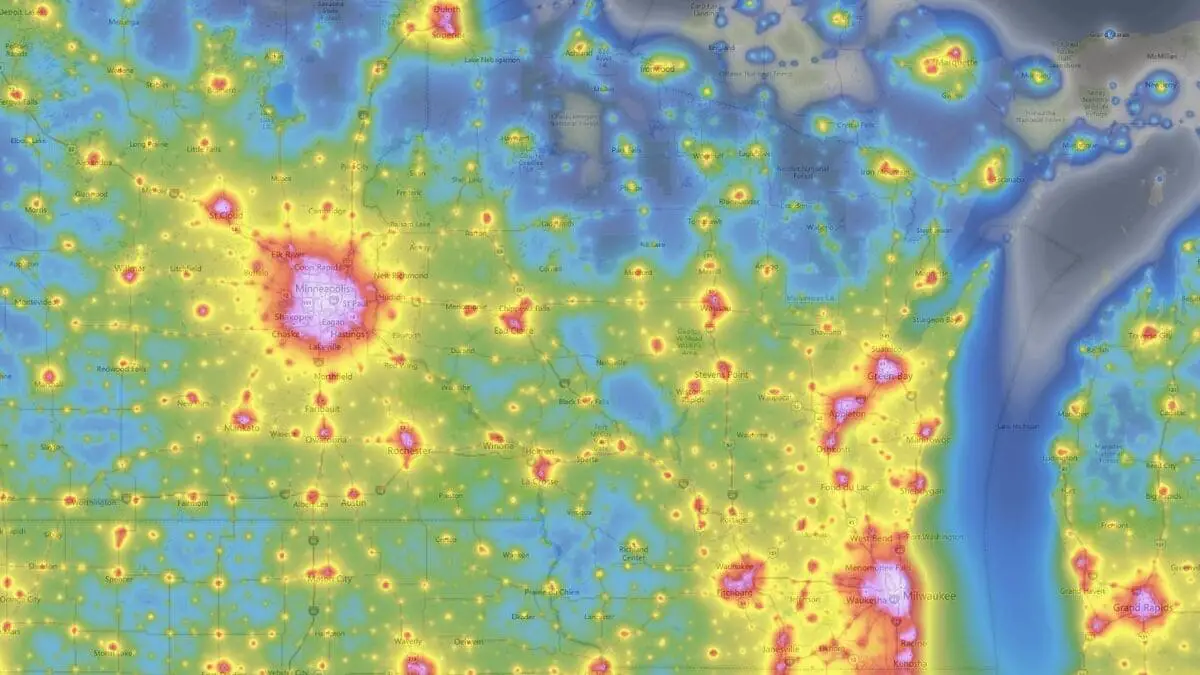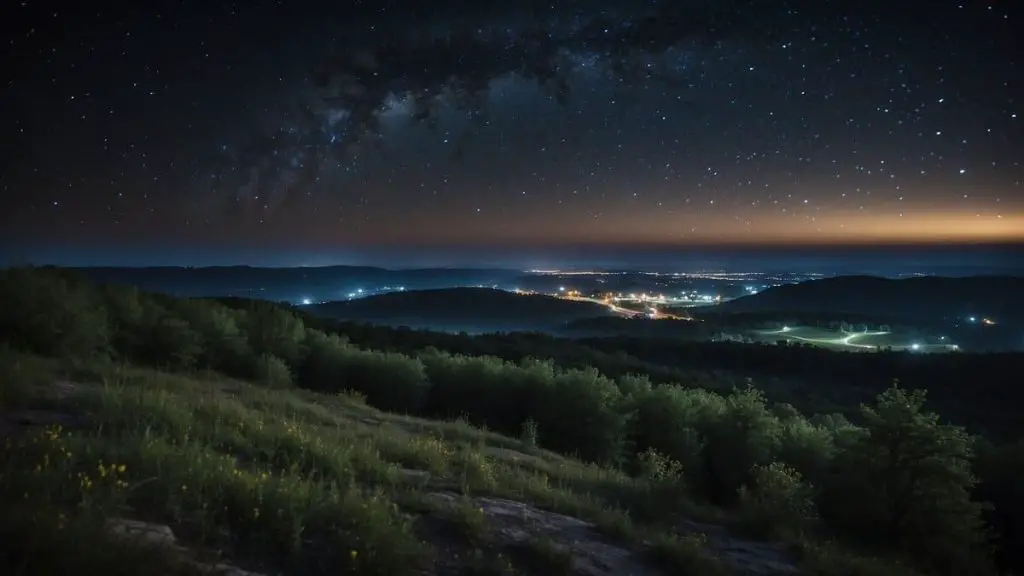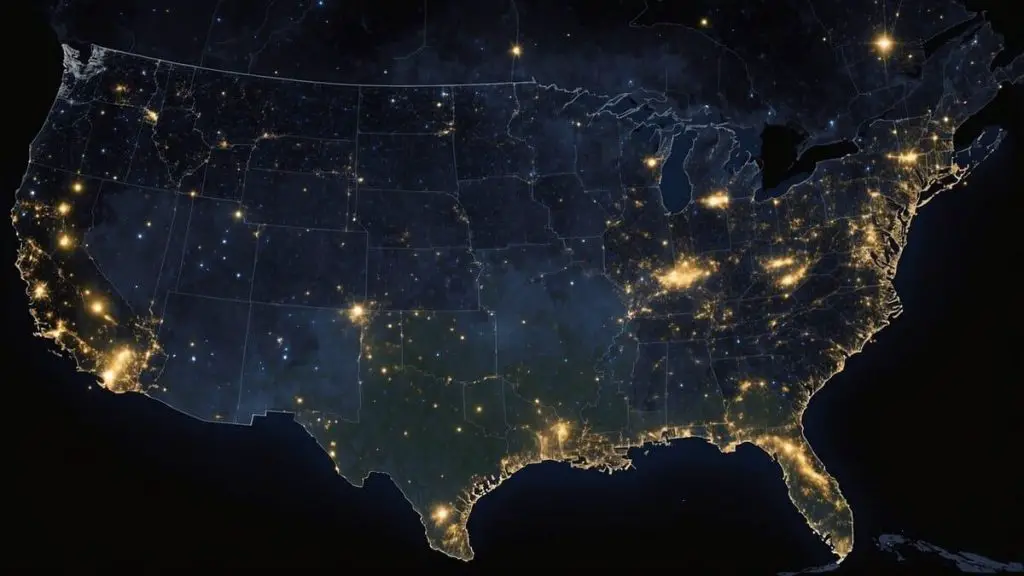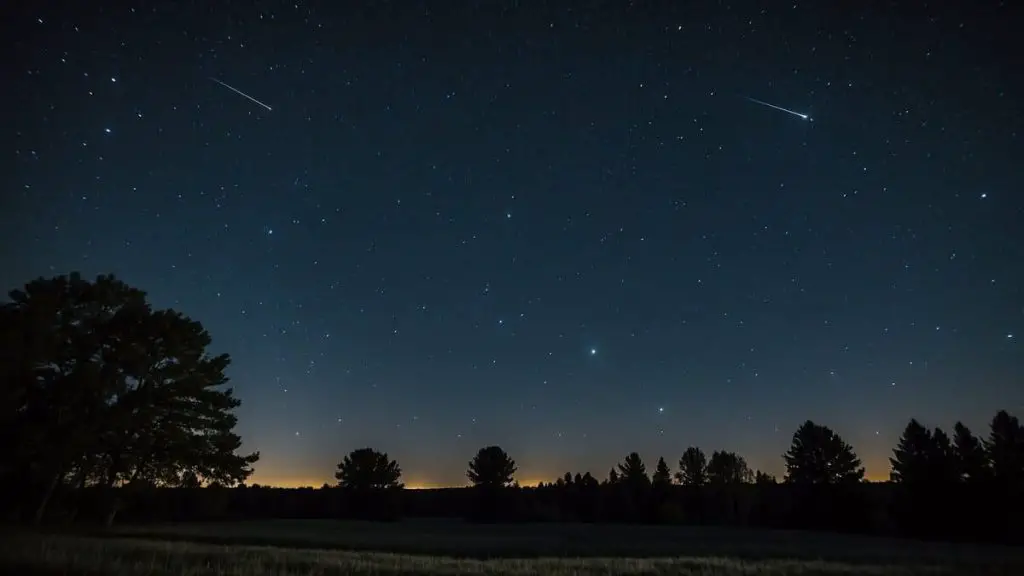You love stargazing, but finding that perfect spot under the stars can be tricky. Actual dark skies are rare and valuable in a world where artificial light is everywhere.
This scarcity of dark skies is more than an inconvenience. It’s a barrier to experiencing the night sky in its full glory. Light pollution hides the stars, disrupts wildlife, and affects our connection with nature.
I’ll show you how Wisconsin’s Dark Sky Parks offer the solution in this article. You’ll discover serene locations free from light pollution, where the stars shine brightest. Here, you can reconnect with the cosmos and appreciate the night sky as it’s meant to be seen.
Key Things to Know:
- Wisconsin’s Dark Sky Parks offer unparalleled stargazing away from light pollution.
- Light pollution affects wildlife and obscures the night sky’s natural beauty.
- These parks provide stellar views and educate on dark sky preservation.
- Ideal for astrophotography and connecting with nature under starlit skies.
Understanding The Wisconsin Dark Sky Map and Dark Skies

In this section, you’ll learn about what a dark sky is, why it matters, and how light pollution affects the night sky. When I first became fascinated by astronomy, understanding dark skies was pivotal.
FREE STARGAZING CHECKLIST
My 5-page Stargazing Checklist will enhance your astronomical observations.
Follow this free checklist to navigate the night sky with confidence, clarity, and a sense of preparedness for a rewarding stargazing experience.

Definition and Importance of Dark Sky
A dark sky is simply one that’s free of artificial light.
It’s important because:
- You can see stars, planets, and galaxies better.
- It helps wildlife that gets confused by too much light at night.
Impact of Light Pollution
Light pollution is when artificial light makes the night sky too bright.
Here’s why it’s a problem:
- It stops you from seeing the true beauty of the night sky.
- It can harm animals and mess up their way of life.
I use outdoor lights that don’t shine upward to keep the skies dark, a small change with a significant impact. Or install fixtures that shield the bulbs so light is directed downward. This small change can make a big difference in reducing light pollution and preserving the wonder of a starry night sky.
Dark Sky Parks in Wisconsin

Wisconsin’s Dark Sky Parks are must-visit spots for the best night sky views if you love stargazing. Let’s explore what makes these parks unique and where you can find them.
Criteria for Dark Sky Parks
During my visits, I’ve noticed how Dark Sky Parks’ rules effectively keep the stars visible.
Here’s what makes a park “Dark Sky”:
- Low light pollution: This means fewer city lights to block out stars.
- Commitment to education: Parks help people learn why dark skies are essential.
- Public access: You can visit and look up at the stars.
List of Dark Sky Parks in Wisconsin
Here are some places in Wisconsin that are great for stargazing:
- Newport State Park: My visit to Newport State Park, Wisconsin’s first International Dark Sky Park, was unforgettable. Located at the tip of Door Peninsula.
- Kickapoo Valley Reserve: At Kickapoo Valley Reserve, I was amazed by its natural darkness, which is perfect for stargazing.
- Wildcat Mountain State Park: Offers stunning night sky views from its observation point.
Remember, these parks offer more than just stars; they preserve the night sky for everyone to enjoy.
Prominent Wisconsin Dark Sky Parks

In my experience, Wisconsin’s night sky parks offer some of the most stunning starry views I’ve ever seen. Let’s check out where you can find the best stargazing spots.
Newport State Park Overview
Newport State Park sits at the tip of Door Peninsula, right beside the cool waters of Lake Michigan. If you’re looking for a dark sky haven, this is it. Here’s what makes Newport unique:
- Darkness: Ranked highly on the Bortle scale for minimal light pollution.
- Location: Set on Lake Michigan’s shoreline for unobstructed views of the heavens.
Kickapoo Valley Reserve Features
The Kickapoo Valley Reserve, tucked away in Vernon County, promises a night sky like few other places. It’s wild and vast, and here’s why you’ll love it:
- Natural beauty: Rolling hills provide a unique backdrop for celestial events.
- Sky quality: It collaborates with Wildcat Mountain State Park to preserve the dark sky.
Wildcat Mountain State Park Opportunities
Think of Wildcat Mountain State Park as your stellar outpost in the Mississippi Valley. It’s about more than just stars; it’s an adventure spot:
- Activities: Combine stargazing with hiking and camping for a complete experience.
- Conservation: Working to become an International Dark Sky Park alongside the Mississippi Valley Conservancy.
When you’re ready to gaze at the stars, these parks provide the perfect dark sky sanctuaries. Pack your telescope, grab a map, and get ready to be amazed by the Wisconsin night sky.
Conservation Efforts and Community Engagement

In Wisconsin, the night sky is getting the attention it deserves. Thanks to conservation efforts and community involvement, you can experience the stars like never before.
Dark Sky Designation Process
International Dark-Sky Association (IDA) sets the global standard for places to earn a dark sky designation.
To get this title, areas in Wisconsin follow these steps:
- Lighting Inventory: List all light sources in the area to see the starting point.
- Management Plan: Create rules to limit light pollution in the future.
- Dark Sky Education: Teach locals and visitors why dark skies are critical.
- Community Partners: Get local businesses and groups on board for support.
Places like Kickapoo Valley Reserve aim to become recognized Dark Sky Parks by matching IDA’s criteria.
Local Astronomers and Educational Initiatives
As an amateur astronomer, I value the educational initiatives of local astronomers.
- Astronomy Programs: Groups like amateur astronomer societies offer programs where you can learn about the stars and how to protect our night sky.
- Stargazing Workshops: These events make learning fun and practical, showing you how to enjoy the night sky responsibly.
Education and outreach are massive. With community partners, they spread the word on dark skies and their importance. Together, they help to turn Wisconsin’s night sky into a starry wonder for everyone to enjoy.
Visitor Information and Resources

When you plan a night under the stars, knowing what to expect and how to prepare is important. This section covers everything from activities you can enjoy to tips for the best dark sky experience.
Activities and Experiences for Stargazers
Backpack Camping:
- Find a public land where you can set up camp and enjoy the night sky to its fullest.
- Check the KVR calendar for special stargazing events.
Stargazing Opportunities:
- Wildcat Mountain State Park offers stellar views of galaxies from its Upper Picnic Area Observation Point.
- Consider taking a sky quality survey to rate the darkness of the skies at various parks.
Planning Your Visit to a Dark Sky Park
What to Bring:
- A red flashlight to keep your eyes adjusted to the dark.
- Layers of clothing and a blanket for the cool night temperatures.
Tips for Stargazers:
- Plan your visit around new moon phases when the skies are darkest.
- Consult Wisconsin’s dark sky map for the best viewing locations.
Tourism and Safety:
- Always stay safe and follow the park’s guidelines for a worry-free visit.
- Take advantage of free public land access to immerse yourself in stargazing.
Remember, these parks are gems for any stargazer, offering experiences that connect you with the cosmos. Ensure you’re ready for an adventure that’s truly out of this world!
Wisconsin and Regional Dark Sky Impact

Wisconsin’s dark skies illuminate more than just stars. They shine on opportunities for local economies and create connections across the Midwestern sky.
Economic and Tourism Benefits
When you look up at the night sky in Wisconsin, you’re not just seeing stars – you’re witnessing a booming part of the local economy. Like those found using a Clear Sky Chart in Wisconsin, dark sky parks draw visitors from near and far.
Here’s how they impact the economy:
- Local Business Growth: Restaurants, hotels, and shops see more customers.
- Job Creation: More visitors mean more jobs in the tourism and service industries.
- Educational Opportunities: Schools and organizations host star parties and educational events.
Dark Skies in the Midwest Context
The Midwest is vast, but its night skies are a shared treasure. Dark skies tie together Wisconsin with neighboring states.
Here’s what makes them unique:
- Contrast to Urban Areas: Compared to bright city lights, the Midwest’s rural areas offer clearer views of the Milky Way.
- Collaborative Efforts: States work together to promote dark sky sanctuaries, boosting regional tourism.
- Astronomy Clubs: They are your go-to guides for the darkest places and the best stargazing experiences.
Frequently Asked Questions

Can I participate in stargazing events at Wisconsin Dark Sky Parks?
Yes, you can participate in stargazing events at Wisconsin Dark Sky Parks. These parks often host guided night sky tours and astronomy workshops, offering a unique opportunity to learn about constellations and celestial phenomena under expert guidance.
Are there any special equipment requirements for stargazing in these parks?
No special equipment is required for stargazing in these parks, but bringing a telescope or binoculars can enhance your experience. A red flashlight is also recommended to maintain night vision while navigating dark.
How can I contribute to preserving dark skies in Wisconsin?
You can contribute to preserving dark skies in Wisconsin by advocating for responsible lighting in your community, participating in local astronomy clubs, and supporting dark sky initiatives. Every effort helps maintain these natural night-time environments.
TL;DR
- Wisconsin’s Dark Sky Parks offer exceptional stargazing experiences, free from light pollution.
- Light pollution hinders star visibility and disrupts wildlife, highlighting the importance of dark skies.
- These parks provide educational opportunities about the significance of preserving natural night skies.
- Personal experiences at parks like Newport State Park and Kickapoo Valley Reserve reveal their unique beauty and tranquility.
- Community involvement and sustainable lighting practices are vital to maintaining these dark sky sanctuaries.
Your thoughts and queries are invaluable to me! Whether you’re a seasoned stargazer or just starting out, I’d love to hear your perspective or answer any questions you might have.
Please share them in the comments section below, and let’s spark a conversation under the stars!
Read my other Dark Sky Maps articles:




